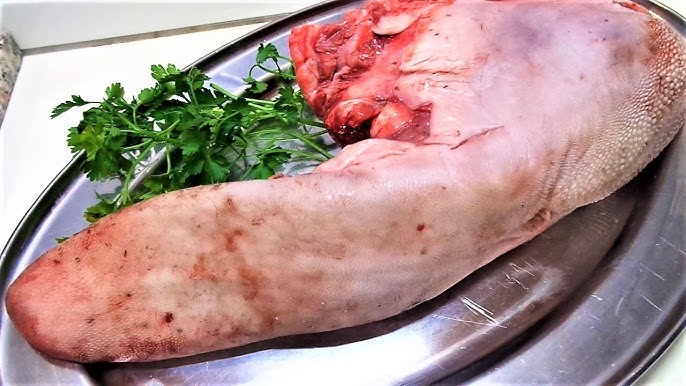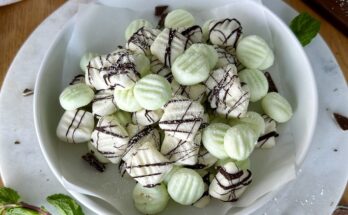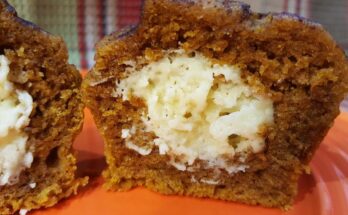Cow Tongue Recipe: Cow tongue might sound intimidating at first, but trust me—it’s one of the most flavorful and tender cuts of beef you’ll ever try. While some people shy away from it because of its unusual look, those who’ve tasted it know it’s a hidden gem in the culinary world. Across many cultures—Mexican, Asian, European, and even African—cow tongue is a delicacy, often used in tacos, stews, soups, or served roasted as a main dish.
What makes it so special? Unlike other tough cuts of beef, the tongue has a naturally rich flavor and buttery texture once cooked properly. The key lies in slow cooking and proper preparation. Think of it like brisket—it needs time, patience, and seasoning to shine. Whether you want to enjoy tender slices in a sandwich, dice it for tacos, or simmer it in a hearty stew, cow tongue is a versatile dish worth adding to your kitchen repertoire.
Health Benefits of Eating Cow Tongue
Cow tongue isn’t just delicious—it’s also highly nutritious. This cut is packed with protein, which helps in muscle building and repair, making it an excellent option for athletes and fitness enthusiasts. It’s also rich in essential vitamins like B12, which supports energy production and healthy red blood cells, and zinc, which strengthens your immune system.
Compared to other beef cuts, tongue is lower in fat than you might expect, especially when trimmed well before cooking. It provides a good balance of healthy fats that keep you satisfied without being overly greasy. Plus, because of its nutrient density, it can be an excellent addition to a balanced diet.
So, the next time you’re considering a protein-rich meal, don’t overlook this underrated cut. Not only will it add variety to your meals, but it’ll also boost your health with every bite.
Ingredients You’ll Need for Cow Tongue Recipe
Cooking cow tongue doesn’t require fancy ingredients. In fact, most of what you’ll need is likely already in your kitchen. Here’s a list to get you started:
Main Ingredient
- 1 whole cow tongue (about 2–3 pounds)
Aromatics & Vegetables
- 1 large onion (quartered)
- 3–4 cloves garlic
- 2–3 bay leaves
- 2 carrots (chopped)
- 2 celery sticks (chopped)
Spices & Herbs
- 1 tablespoon black peppercorns
- 1–2 teaspoons salt (adjust to taste)
- Fresh parsley or cilantro (for garnish)
- Optional: cumin, oregano, or paprika for added depth
Liquids
- Enough water or beef broth to fully cover the tongue
Kitchen Essentials
- Large pot or slow cooker
- Sharp knife
- Cutting board
- Tongs (for handling hot meat)
These basics will give you a flavorful base, but you can always adjust with your favorite spices and herbs to make the recipe your own.
Preparing Cow Tongue Before Cooking
Preparation is the most important step when cooking cow tongue. Since it’s a tougher cut with a thick outer layer, you’ll want to clean it properly before cooking. Start by rinsing it under cold water to remove any debris. Some cooks like to soak it in water with a splash of vinegar for about 30 minutes to help get rid of any impurities and odors.
Next, pat it dry and inspect the tongue. You don’t need to peel the skin yet—that comes after boiling. What you can do at this stage is trim off any excess fat from the underside. If you want extra flavor, marinate the tongue overnight in a mix of garlic, onions, spices, and citrus juice. While this step isn’t mandatory, it helps infuse deeper flavor into the meat.
Proper prep ensures you’re not left with a bland or tough final dish. It sets the stage for that melt-in-your-mouth tenderness cow tongue is known for.
Step-by-Step Guide to Cooking Cow Tongue
There are several ways to cook cow tongue, but the most common (and beginner-friendly) method is boiling. This ensures the meat becomes tender and easy to peel before slicing. However, you can also experiment with roasting, grilling, or slow-cooking depending on your preference. Let’s break down the process:
Step 1 – Cleaning and Prepping the Tongue
Before you even touch the stove, give the tongue a good rinse. Make sure all traces of blood are washed away. If you’re using vinegar water for soaking, rinse again to avoid a sharp taste. This is where trimming comes in—remove any hanging fat or gristle.
Think of this step as the foundation of your dish. A well-prepped tongue will not only taste better but also cook more evenly. Skipping it might leave you with unwanted textures or lingering flavors.
Step 2 – Boiling the Cow Tongue
Boiling is the traditional and easiest way to cook cow tongue. Place the cleaned tongue into a large pot and cover it completely with water or beef broth. Add the onion, garlic, carrots, celery, bay leaves, peppercorns, and salt. Bring the pot to a boil, then reduce to a gentle simmer.
Patience is key here—the tongue needs time to tenderize. Depending on the size, it usually takes about 2.5 to 3 hours of simmering. During this time, the flavors from the aromatics will seep into the meat, transforming it into something rich and savory. You’ll notice the broth developing a golden hue and an appetizing aroma filling your kitchen.
Check occasionally to skim off any foam or impurities that rise to the surface. By the end of boiling, the tongue should feel tender when pierced with a fork. This step ensures the meat is juicy and perfectly seasoned before peeling.
Step 3 – Removing the Skin
Once boiled, the cow tongue will be tender enough to peel. This part might sound tricky, but it’s actually simple when done right. Remove the tongue from the pot using tongs and let it cool slightly until it’s safe to handle. While still warm, make a small cut along the top, then peel off the thick, white outer layer. It should come off easily, revealing soft, pink meat underneath.
If you let the tongue cool too much, peeling becomes harder—so do it while it’s warm. Don’t worry if some bits of skin remain; just use your knife to scrape them away. This step is essential because the outer skin is tough and chewy, not pleasant to eat. Once peeled, you’ll have a tender piece of beef ready for slicing or further cooking.
Step 4 – Slicing and Serving
Now comes the fun part—slicing and enjoying your cow tongue. Use a sharp knife to cut it into thin slices, almost like deli meat. The slices should be tender, with a slightly buttery texture. You can serve them as-is with some of the broth, or take things further by pan-searing the slices for a crispy edge.
Cow tongue is extremely versatile. You can use it in sandwiches, serve it alongside mashed potatoes and gravy, or dice it into cubes for tacos. The mild, beefy flavor pairs beautifully with bold sauces like chimichurri, salsa verde, or even classic barbecue sauce.
If you want a heartier meal, serve the slices with roasted vegetables or in a rich stew. No matter how you present it, cow tongue is bound to surprise anyone who tries it for the first time.
Different Variations of Cow Tongue Recipes
The beauty of cow tongue is its adaptability across cuisines. Different cultures prepare it in unique ways, each bringing out new flavors and textures.
Mexican Lengua Tacos
This is perhaps the most popular preparation worldwide. After boiling and peeling, the tongue is sliced or diced, then sautéed with onions, garlic, and spices. It’s served in corn tortillas with fresh cilantro, lime, and salsa. The tender beef combined with zesty toppings makes it irresistible.
Braised Cow Tongue
For a European twist, braise the peeled tongue in a mixture of wine, broth, onions, carrots, and herbs. Slow-cooking in the oven creates a rich, flavorful dish perfect for special occasions. The result is a fork-tender roast with a deep, comforting flavor.
Cow Tongue Stew
Popular in many Asian and African cuisines, tongue stew is hearty and full of flavor. Chopped tongue is simmered with tomatoes, potatoes, and spices until everything melds into a thick, savory dish. It’s the kind of meal that warms you from the inside out.
No matter which variation you choose, cow tongue adapts beautifully to spices and cooking techniques.
Tips and Tricks for Cooking Cow Tongue
Cooking cow tongue is straightforward once you know the basics, but a few tips can help you nail it every time:
- Don’t rush the boiling process – Low and slow cooking ensures tenderness.
- Peel while warm – Waiting too long makes the skin harder to remove.
- Use broth instead of plain water – It enhances the flavor of both the meat and the broth.
- Season generously – Since tongue is thick, it benefits from bold seasoning.
- Store properly – Keep leftovers in an airtight container in the fridge for up to 4 days.
When reheating, steam or simmer gently instead of microwaving, as high heat can make it dry. With these tips, you’ll never have to worry about ending up with tough or bland tongue again.
Serving Ideas and Pairings
Cow tongue is incredibly versatile, which means you can serve it in countless ways depending on the occasion. If you’re hosting a casual dinner, thinly sliced tongue works perfectly in sandwiches or tacos. The tenderness of the meat combined with crispy bread or soft tortillas makes for a satisfying bite. Add a splash of salsa, chimichurri, or even simple mustard to elevate the flavors.
For a more traditional approach, serve it with mashed potatoes, roasted vegetables, or rice. The richness of the tongue pairs beautifully with creamy or starchy sides that balance out the beefy taste. You can also use the cooking broth as a base for gravy or soup, ensuring nothing goes to waste.
If you’re pairing drinks, red wine complements roasted or braised tongue, while a cold beer or margarita pairs wonderfully with Mexican-style tacos. For a refreshing non-alcoholic option, consider lime soda or iced tea to cut through the richness. No matter the setting, cow tongue can be dressed up or kept simple, making it a crowd-pleaser every time.
FAQs about Cow Tongue Recipe
1. Does cow tongue taste like regular beef?
Yes, but with a twist. Cow tongue has the same beefy flavor you’d expect, but the texture is much more tender and buttery when cooked correctly. It’s often described as melt-in-your-mouth beef.
2. How do you make cow tongue tender every time?
The secret lies in slow cooking. Boiling or braising the tongue for at least 2.5 to 3 hours ensures it becomes soft and juicy. Rushing the process can leave it tough and chewy.
3. Is the outer skin edible?
No, the outer layer is too tough to eat. That’s why peeling it after boiling is an essential step. Once removed, you’re left with tender, flavorful meat.
4. What can you do with leftover cow tongue?
Leftovers are excellent for tacos, sandwiches, fried rice, or even salads. Just dice it up and mix it with your favorite seasonings for a quick meal.
5. Can you use the broth from boiling cow tongue?
Absolutely! The broth is rich and flavorful, making it perfect for soups, stews, or even as a base for sauces.
Conclusion
Cow tongue might not be the first cut of beef you think of when planning dinner, but it deserves a spot on your table. From its rich nutritional benefits to its buttery texture and adaptability across cuisines, it’s a dish that surprises most people after just one bite. Whether you keep it simple with boiled slices, get adventurous with lengua tacos, or go gourmet with braised tongue, you’ll discover why so many cultures treasure this underrated cut.
If you’ve never tried cooking cow tongue before, follow this step-by-step guide, and you’ll see how rewarding the process can be. Not only will you end up with a flavorful meal, but you’ll also gain a new level of confidence in the kitchen. Give it a chance—you might just find your new favorite beef recipe.



